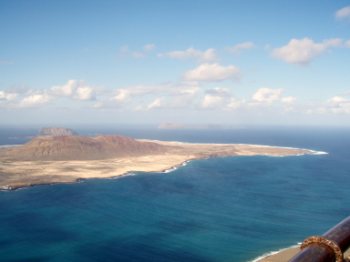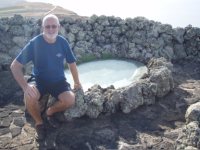Mirador del Rio

|
Mirador del Rio
After my excitement at seeing the crabs in the volcanic
bubble, off we went further north.
 We paid our entry and were guided by a wavelike corridor
suddenly being connected with a dining hall of extensive windows allowing us to
take in a fantastic panorama over the archipelago, this was our first view. Bear went off to get us a roll for lunch
and we sat gazing at the view for some time. Belonging to the
locality of Haria and exactly situated at the peak of the Famara
Cliff at a height of 470m, the Mirador del Rio can be found at the
place where once was situated the "Bateria del Rio", a line of cannons used in
the war between Spain and the USA for the sovereignty of Cuba in the 19th
century. The Mirador was designed in 1973 by Cesar Manrique with the help of
Jesus Soto and Eduardo Caceres. It was a quite complex construction: the peak of
the Famara Cliff had to be gouged in order to disguise the visual impact in the
rock face of the cliff.
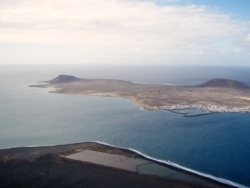   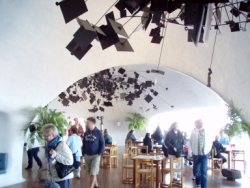 View of Graciosa,
the high coastal road off to the left, the glass panel just visible is where we ate lunch, the dining room with the hanging
sculptures, welded from objects and rubbish, these iron
sculptures soldered by Manriques own hand in order to lessen the reverberation
produced inside the gouged rock. Especially striking is the front side, a semicircular construction of
stone.
  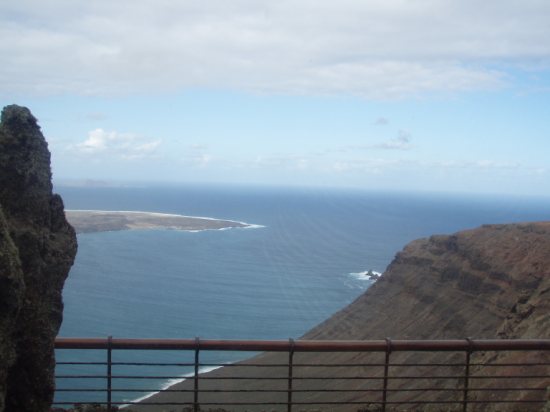 Graciosa with
Bear, the harbour and colours, changing constantly with passing
clouds.
The first island is La Graciosa . Behind La Graciosa you can see the Montaña Clara and the Roque del Oeste and finally the isle of Alegranza. Last but not least you need a clear day in order to catch sight of the Roque del Este. From the Mirador can also be seen the base of the Famara Cliff where you can find the oldest salt refinery of Lanzarote called Salina del Rio and exploited since the Roman age. Mirador del Rio is so named because of the 2km of ocean separating La Graciosa from Lanzarote is called the Rio (River) by the islanders.
Graciosa Island or commonly La Graciosa (Spanish for graceful) is part of The Parque Natural del Archipielago Chinijo, Reserve of the Biosphere, "Marine Reserve of La Graciosa and the islands to the North of Lanzarote" it is linked to the municipality of Teguise. The island forms a part of the Chinijo Archipelago. The village is in the south eastern part of the island with houses encircling the harbour which has two piers and a yacht area in the bay. Other smaller islands include Montana Clara (Spanish for clear mountain) which is an archipelago to the northwest, Roque del Este, Roque del Oeste and Alegranza to the north. The only two settlements include Caleta del Sebo and summer residence Casas de Pedro Barba. The island is entirely made up of volcanic rock and sands. The population is around 700. Tourism is the main industry along with fishing. Every year, tourists flock to the island for its tempered climate and its sandy volcanic coast. The island has a school, lyceum, post office, supermarkets, a bank, port, beaches and bar-restaurants, a square where bicycles can be hired. Streets and roads are unpaved sand, the Gracioseras can be seen early each morning sweeping the streets smooth of the previous night's footprints. Cars are strictly prohibited and limited to a handful of licensed vehicles for special purposes. Since the roads are bad, and cars have to be shipped to Lanzarote for repair, about 70% of the vehicles on the island are old Land Rovers which often can be repaired by a local serviceman. Access to the Island is by a thirty five-minute ferry crossing from Orzola on Lanzarote to the harbour in the village. Graciosa Island has been raided by pirates for treasures in the past.
Location: Northern Principality of Haria
Phone Number: +34 928.52.65.48
Opening Hours: 10:00 to 18:00
Services: Bar, from 10:00 to
17:45
Prices: 4.50€ per Adult.
 All in all extraordinary views,
you felt you could almost
touch.
|


